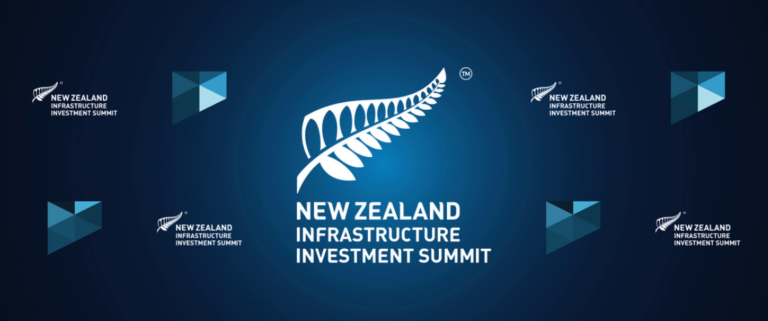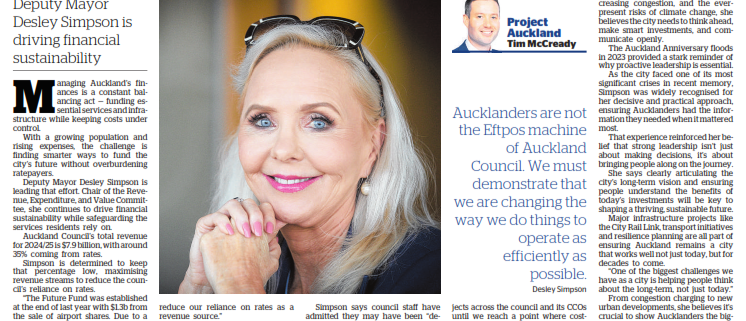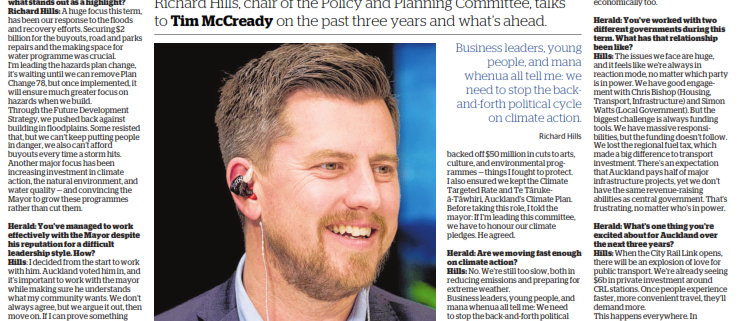Project Auckland: Smarter ways to fund the city's future (NZ Herald)
Project Auckland: Smarter ways to fund the city’s future (NZ Herald)
Managing Auckland’s finances is a constant balancing act — funding essential services and infrastructure while keeping costs under control.
With a growing population and rising expenses, the challenge is finding smarter ways to fund the city’s future without overburdening ratepayers.
Deputy Mayor Desley Simpson is leading that effort. Chair of the Revenue, Expenditure, and Value Committee, she continues to drive financial sustainability while safeguarding the services residents rely on.
Auckland Council’s total revenue for 2024/25 is $7.9 billion, with about 35% coming from rates.
Simpson is determined to keep that percentage low, maximising revenue streams to reduce the council’s reliance on rates.
“The Future Fund was established at the end of last year with $1.3b from the sale of airport shares.
“Due to a higher price and lower fees, we received approximately $31 million more than anticipated,” she says.
“From the next financial year, the Future Fund will return around $68m to council per year. That is $42m more than the original $26m estimated from holding the airport shares.”
Another key source of revenue is Port of Auckland, expected to deliver $1.1b in profits over the next 10 years.
“In 2023/24, the port delivered $42m back to Council, and by 2027, that figure will rise to $110m. This kind of profitability within the group helps reduce our reliance on rates as a revenue source.”
Over this financial year, Auckland Council is working towards $66m in additional savings, having already achieved $43.2m of that, on top of ongoing savings of $90m per year.
Simpson is clear that financial efficiency isn’t just about cutting costs but about ensuring that every dollar is spent wisely and delivers value for ratepayers.
“We also need to prove to Aucklanders that we can manage the delivery of projects well and deliver value for money. Sadly, that’s not always been the case.”
Simpson says council staff have admitted they may have been “desensitised to costs” in the past.
To address this, the council has launched the Better Value Projects programme, aimed at improving how capital projects are procured and executed.
“We have started by analysing three projects: the Milford Beach steps, Jubilee Bridge, and the Meola Rd upgrade,” explains Simpson.
“In each case, staff acknowledged that the projects could (and should) have been delivered better.
“This is just the beginning. Every meeting will continue to analyse projects across the council and its CCOs until we reach a point where cost-consciousness and efficiency are embedded across all departments.
“Aucklanders are not the Eftpos machine of Auckland Council. We must demonstrate that we are changing the way we do things to operate as efficiently as possible.”
Leadership and clear communication
Simpson’s focus on financial sustainability is about more than just balancing the books; it’s about ensuring Auckland is prepared for the challenges ahead.
With a growing population, increasing congestion, and the ever-present risks of climate change, she believes the city needs to think ahead, make smart investments, and communicate openly.
The Auckland Anniversary floods in 2023 provided a stark reminder of why proactive leadership is essential.
As the city faced one of its most significant crises in recent memory, Simpson was widely recognised for her decisive and practical approach, ensuring Aucklanders had the information they needed when it mattered most.
That experience reinforced her belief that strong leadership isn’t just about making decisions, it’s about bringing people along on the journey.
She says clearly articulating the city’s long-term vision and ensuring people understand the benefits of today’s investments will be key to shaping a thriving, sustainable future.
Major infrastructure projects like the City Rail Link, transport initiatives and resilience planning are all part of ensuring Auckland remains a city that works well not just today, but for decades to come.
“One of the biggest challenges we have as a city is helping people think about the long-term, not just today.”
From congestion charging to new urban developments, she believes it’s crucial to show Aucklanders the bigger picture and that shifting the conversation from short-term inconveniences to future benefits is essential.
“These changes aren’t just about the present.
“They’re about a city that runs more smoothly, is more sustainable, and works better for everyone in the long run,” Simpson says.
“We have a unique opportunity ahead of us,” she says.
“Auckland has a wonderful future as long as we continue to think ahead, plan smart, and take people along on the journey.”
Project Auckland: The issues Auckland faces are huge (NZ Herald)
Councillor Richard Hills, chair of the Policy and Planning Committee, talks to Tim McCready on the past three years and what’s ahead.
Looking back on this term, what stands out as a highlight?
Richard Hills: A huge focus this term, has been our response to the floods and recovery efforts. Securing $2billion for the buyouts, road and parks repairs and the making space for water programme was crucial.
I’m leading the hazards plan change, it’s waiting until we can remove Plan Change 78, but once implemented, it will ensure much greater focus on hazards when we build.
Through the Future Development Strategy, we pushed back against building in floodplains. Some resisted that, but we can’t keep putting people in danger, we also can’t afford buyouts every time a storm hits.
Another major focus has been increasing investment in climate action, the natural environment, and water quality – and convincing the Mayor to grow these programmes rather than cut them.
You’ve managed to work effectively with the Mayor despite his reputation for a difficult leadership style. How?
Hills: I decided from the start to work with him. Auckland voted him in, and it’s important to work with the Mayor while making sure he understands what my community wants. We don’t always agree, but we argue it out, then move on.
If I can prove something benefits Aucklanders or the environment and is cost effective, he’ll support it. But it goes both ways.
For example, I didn’t expect to support selling the airport shares, but that decision helped reduce debt and create extra revenue through the Future Fund. In exchange, the Mayor backed off $50 million in cuts to arts, culture, and environmental programmes. Things I fought to protect.
I also ensured we kept the Climate Targeted Rate and Te Tāruke-ā-Tāwhiri, Auckland’s Climate Plan. Before taking this role, I told the Mayor: If I’m leading this committee, we have to honour our climate pledges. He agreed.
You’ve worked with two different governments during this term. What has that relationship been like?
Hills: The issues we face are huge, and it feels like we’re always in reaction mode, no matter which party is in power.
We have good engagement with Chris Bishop (Housing, Transport, Infrastructure) and Simon Watts (Local Government). But the biggest challenge is always funding tools. We have massive responsibilities, but the funding doesn’t follow.
We lost the regional fuel tax, which made a big difference to transport investment. There’s an expectation that Auckland pays half of major infrastructure projects, yet we don’t have the same revenue-raising abilities as central government. That’s frustrating, no matter who’s in power.
Are we moving fast enough on climate action?
Hills: No. We’re still too slow, both in reducing emissions and preparing for extreme weather.
Business leaders, young people, and mana whenua all tell me: we need to stop the back-and-forth political cycle on climate action.
We’re rolling out busways and rail projects, electric buses, improving cycling and walking options, and investing in clean energy, but compared to Australia, Europe, and Asia, we’re falling behind. Other cities are moving faster, and if we don’t keep up, we’ll pay for it economically too.
What’s one thing you’re excited about for Auckland over the next three years?
Hills: When the City Rail Link (CRL) opens, there will be an explosion of love for public transport. We’re already seeing $6 billion in private investment around CRL stations. Once people experience faster, more convenient travel, they’ll demand more.
This happens everywhere. In Australia, when metro or light rail opens, people suddenly want more. The same will happen here.
That’s why it’s frustrating that light rail was cancelled. The city to Māngere corridor still has no rapid transit, despite being one of Auckland’s fastest-growing areas.



